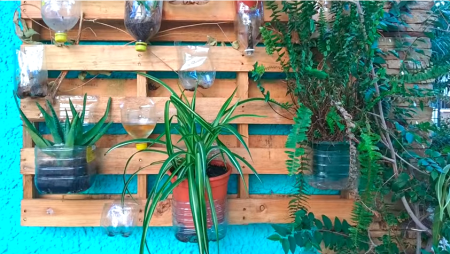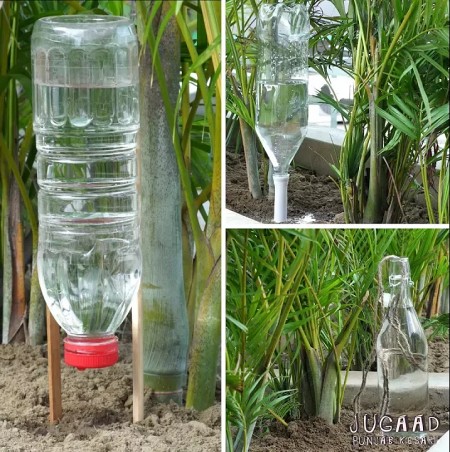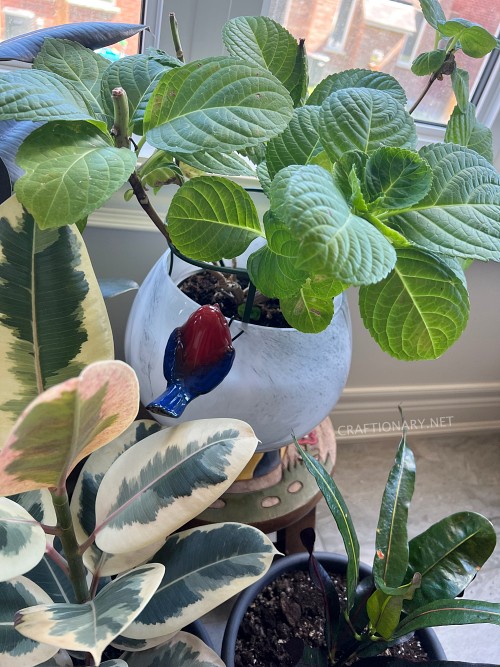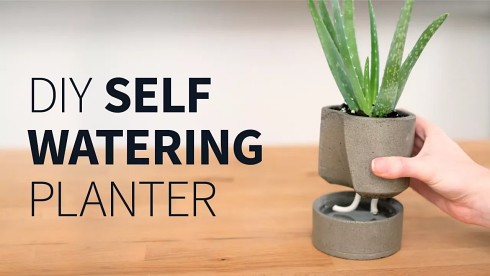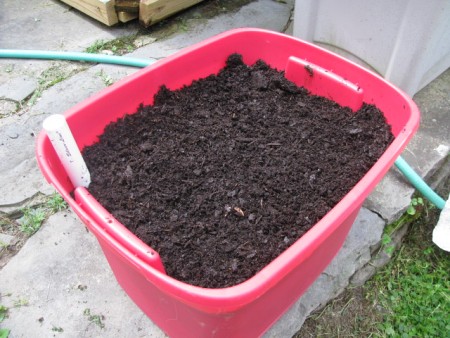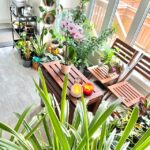This post may contain affiliate links. Please see our full Disclosure Policy for details.
To keep plants healthy, you must give them water and sunlight regularly. Sometimes it gets difficult to give them water properly and plants die. Self-watering planters DIY make gardening easier. When we are out of the city or away from plants, they take care of our plants by giving water to them whenever needed. You don’t have to ask your friend or neighbor to make time out of their busy schedule to water your plants. You can buy a self-watering planter for your plants, however, making a self-watering planter at home is cheap and saves you money. This is great for busy garden lovers as well as travelers to ensure their plants stay alive, healthy and not over watered.
Self watering planters DIY have low maintenance features and their latest designs help plants stay healthy. These devices are also ideal for gardeners who want to save water. The overflow system in self watering pot acts as drainage hole and collects excess water at the bottom preventing root rot. Some have a built-in moisture wicking system while others use exact amount of water as needed reducing water waste. Many sophisticated self watering planters DIY can water your plants for three to four weeks.
You will also like: DIY indoor planter box idea with IKEA plant stand flower box

self watering planters
How does a self watering planter work?
You can make your planter self water using this method. Note that self watering planters don’t water by themselves but help prolong the frequency of manually watering the plants by providing a moisture source. Self watering systems can be made on a smaller scale indoors or on a larger scale for outdoor gardens as well.
The basic concept behind self watering is a water reservoir and a connector that acts as a portal between water and roots. The reservoir is normally located at the bottom of the container. Note that if you live in a hot climate region, you will have to reduce the loss of water by evaporation. The connector can be any material that observes water such as a wick, string, fabric, or sponge.
A soil foot system will encourage plant roots to seep water from the bottom when needed. One end of the wick is submerged in water and the other is in the soil. The wick system acts as a capillary action system allowing water to travel into the planter. You will have to refill the water reservoir as required.
Check out: 50 Fast growing plants for privacy to best screen backyards
How often you should fill water in Self Watering Planters?
The size and variety of plants both play a key role in water refill frequency. A rule of thumb Is to test your self watering system and refill it when the water level is low. Normal-size indoor self watering planters require refilling every week or two depending on your houseplant needs.
Plants that thrive in self watering systems
Based on market research self watering planters are not ideal for all plant species. They are best for tropical plants, herbs, and vegetables that require frequent watering like pothos, cherry tomatoes, basil, palm, fern, spider. Most annuals and perennials are happy in self watering environment too. However, plants that like very moist soil may find bottom up watering system challenging.
Plants that don’t thrive in self watering systems
Indoor plants that don’t benefit from a self-watering system are:
- Houseplants that don’t require watering that often like snake plants. You can water them once a week in summer and once a month in winter.
- Avoid self watering aloe plants and cacti as they don’t like regular moist soil.
- Jade plants are succulents, and they don’t need too much water so avoid self watering them.
Self watering planters FAQ
How to make automatic watering system?
You can make one using recyclable plastic bottle. Poke four holes in the plastic cap using heated pin tip. You can use a lighter flame to warm the pin. Now fill water into the bottle and replace the cap on it. Place it upside down into the planter and you are done.
How to water plants for a week when traveling?
You can water your plants at home for a week by filling up water in your sink or bathtub a few inches. Ensure the water doesn’t evaporate by heat. Leave your potted plants in the water ensuring the pots have drainage holes. The bottom up watering system will keep them hydrated for up to one week while you are away. Place a towel on the base of the sink or bathtub to prevent scratches from pots.
How to water plants for 2 months when traveling?
Use a wicking system from a water reservoir to keep your indoor plants hydrated for a month. You will need a large source of water like a gallon of jug or 5 gallons container depending on how many plants you are wicking. Siphon effect will help keep the plants moist as water will wick from the source into the soil and reach the plant roots. Make sure that your water source is higher than the plants so that the water can travel from the wick.
What happens when the water reservoir dries out in self watering planter?
The wicking system will not work if you don’t refill the reservoir and it dries out. If this happens you will need to restart the mechanism by soaking the dirt from the top with the wick at the bottom of the pot.
Should I put rocks at the bottom of a self watering planter?
You may be tempted to put rocks to line the bottom but you don’t need to as the gravel will take up space in the reservoir. The capillary action doesn’t require any rocks and reduces the effectiveness only.
How to prevent a self watering planter from attracting mosquitoes?
Any still water can attract mosquitoes to lay eggs providing ideal moist environment. It is best to flush out water every few days to keep it clean. You should also cover the opening to keep water reservoir out of reach.
How to prevent a self-watering pot from attracting gnats?
A wrong self watering planter can lead to death of a plant by root rot or fungus gnats. An ideal self watering planter is the one that allows moisture for the soil when the roots force the mechanism and has a covered water reservoir.
Can self watering planters cause root rot?
While drainage holes are very important for growing plants some self-watering pots don’t have an overflow opening. Your plant will benefit from a self watering planter that has drainage holes in long term. You can also keep the water source at low level to avoid roots dipping in water. Avoid self-watering pots that can have water log leading to potential root rot.
To keep your plants healthy self watering planters are your best indoor option. They offer the right amount of water for your greenery and herbs. Self watering pots are overpriced and with self watering planter DIY you can save money and water without stretching your budget.
Self watering planters DIY Ideas
Here are a few ideas to get you comfortable into making your self watering system at home that works for your indoor garden. We will cover the following topics:
- Self watering planters you can buy
- Recycle DIY Self watering planters
- Gallon self watering containers
- Houseplant self watering planters
- Vegetables self watering planters
Self watering planters you can buy
There are so many options for buying self watering planters but they are expensive. You can look into alternatives like wine bottle stake and glass plant watering system from amazon.
Wine bottle stakes
Simply insert the bottle stakes into the soil and place the wine bottle on top for self watering plant system while you are away.
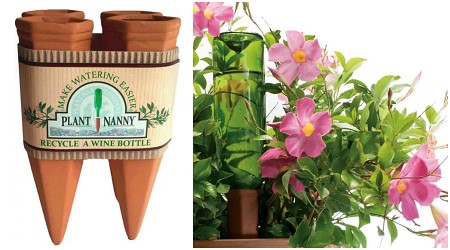
Bottle stakes
Glass Stakes Watering System
Add some color to your garden with self watering globes.

Watering globe
Self watering pots
Self watering pots will be made up of pots having holes in the bottom and the base in which we will add water. Put the plant in the pot and water in the base under the pot. The plant will get water from holes. There are a variety of self watering planters for all budget on amazon.

Self watering planters
Automatic self watering systems
It is perfect if you want to keep your plants watered automatically. It is very straightforward to setup. Just install the tubes into the water tank and watering spikes that you placed in the soil. It works best for multiple plants. You can setup the amount of water and frequency of watering plants. It can water upto 15 pots. It is USB and battery operated. Place the water supply lower than the pump and the plants to avoid causing siphon effect. These are the 3 best options you can get from amazon:

Automatic drip irrigation kit
- Kollea automatic drip irrigation kit
- iPriro houseplants automatic watering system
- DIY micro automatic drip irigation kit
Self-watering planter from recycled bottles
Herbs
You can make a soda bottle self-watering planter with a recycled bottle and a piece of string by craft your happiness. Indoor self watering herb garden keeps your herbs hydrated throughout the year. Make sure to keep it in an area with plenty of sunlight.

Recycle self watering planter
Drip irrigation with self wicking planters
This drip irrigation green wall is made from a plastic bottle. Cut the bottle into two halves, make holes in the cap using a heated pin on candle. Pass the string you made with old fabric or sock through the holes. Now plant in the tube and hang it upside down. Pour water in the bottom half and let the string loose in the water. The roots will seep water from the wet end buried in the soil in the top half by grow veg.
Deep root self watering
You can also promote a deep root system by burying a soda bottle into the soil with random holes punched into it. Fill the water from the top as needed.

Deep root self watering
Cork self watering
Make a self-watering planter by drilling holes in the cork. Insert glass bottle upside down into the soil and keep your plant hydrated for up to three days. Experiment with the size of hole to find optimum watering condition for your plant by the garden glove.
Soda bottle
Self watering planter by the soda bottle needs an old sock and a bottle. It can be made by cutting the bottle from the middle and then pushing the socks into the neck of the bottle. Fill the bottom of the bottle with water. Push the top of the bottle by inverting it so that halves of the bottle fit together. Fill the socks with soil and add a plant now leave it to flourish by plant eat repeat.
Water cooler bottles
If you ever go on vacation, you will need a large water reservoir so your plants will never run out of water. A 5-gallon water cooler bottle provides enough water for your plants by DIY garden ideas.
Disposable bottles
Make self-watering plant with sticks and plastic bottles it will last water for 1-2 days. Attach the sticks with bottles and stand them upside down above the planter. Add water to the bottle and twist the cap of the bottle just a little to allow drops of water to run so that a small amount of water keeps leaking by jugaad.
Secondly, make one with tube underneath and it will last overnight only. The best option is the third one for more days with a string submerged in water that lasts 5-6 days.
Repurposed self watering
Use gold spray paint to give your plastic bottles a modern self-watering planter look that is most suitable and ideal option for indoor garden by craft your happiness.
Milk jug
Self watering planters out of milk jugs. You will need a milk jug, a utility knife, stickers, potting soil, and a plant to make this planter. Make your planter and then ask your kids to paint and decorate their jug planters by must have mom.
How does a wicking bed work?
Keeping your plants and vegetables well-watered can be challenging sometimes. Many green thumb enthusiasts over years have innovated their plant growing techniques. One such popular idea is using a wicking bed as self watering raised garden bed.
A wicking bed is a bigger version of the indoor self watering planter. Large containers and gallons of water reservoir are used to create a sub-irrigation method that works to water the plants automatically. The water is reserved in a large pot that is wicked upward into the plant container.
Best material for wicking plants in self watering systems
The best moisture-wicking fabrics are:
DIY string self watering planters
- The plastic cup will hold the water and the string will convey water to the soil. This self watering planter is cheaper and easy to make by organic garden.
- Glue burlap covered sticks or dowels on the sides to make pillars for the half bottle up and down self watering planter.
- Make a planters tier with glass vase as water reservoir for hanging garden.
- Hanging self watering planter in clay vessels called matki. One acts as reservoir and other for holding plant. The string is used to deliver water to the roots.

String self watering
Self watering hanging baskets mechanism
You will need a plant growing bed, potting soil, water reservoir, and a wicking system to make self-watering hanging baskets. The baskets use capillary action similar to other watering systems using wick to moist the dirt with water. Once the roots soak up water from the soil, it wicks up to sustain moisture.
Find out How to display plants indoor?
Hanging flowerpots
Make pots out of plastic bottles and add plants in pots and hang them. Hang a plastic bottle upside down with water in it. The cap of the bottle has a screw in it so the water leaks from the bottle by creative garden.
Make your own self watering planter from scratch
Use concrete mixture to make self watering planter from scratch that uses wick. If you would like to make one like those store bought types this is your best choice. This gives the plant nice consistent access to water and are perfect for plants like orchids by artsy pretty plants.
Self watering planters DIY containers
Plastic bucket self watering container
Use plastic buckets as a self-watering container. To make a base for this container you will need a Styrofoam cup large or small depending on the water reservoir and two buckets of different sizes by crestone solar school.

Self watering containers
Build 5 gallon self wicking planter
Grow vegetables without a garden in self-watering container for vegetables. You will need towels to use as wicks, 2 containers and sponges. It should be able to sustain itself for 2 days when watering is a problem so that vegetables don’t dry by Gary Pilarchik.
5 gallon bucket self watering container
Place one five gallon bucket inside the other. Cut your PVC pipe and your dowel just long enough to reach from the base of the bottom bucket to the top of the top bucket. The dowel will float and raise up when the water is sufficient, and fall inside the PVC pipe when it isn’t by real life at home. Cover the bottom of the second container with a layer of cheese cloth or coffee filters to prevent soil from washing into the water reservoir.
Cheap self watering container
Make Self-watering container by cutting the lid such that it fits inside the container. Stick two 2×4’s on the side of the lid to keep it above the bottom of the container and create water reservoir. Insert a pipe through the lid to reach the empty space between the lid and the container. Cut a hole in the center of the lid and place a plastic pot with drainage holes to create soil foot. Use duct tape to attach all the parts together. Fill the foot with damp soil, packing it in tightly. The plant accesses the water from soil foot. The rest of the container is to be filled with potting soil by common sense home.
Easy self watering planter
Convert a standard planter into a self-watering container with a watertight container, a water bottle, two strips of fabric, and an electric drill or a sharp knife by bucolic bushwick.
Air Conditioner self watering system
Use the water from air conditioner to water the plants. You can create a self watering planter using a pipe that gathers water from the AC. This process makes it possible for plants to get small watering several times all day long. Water from the air conditioner tends to be very cool and prevents the plants from overheating. It also saves water and is chemical free by Louis Indy1.
Genuine self watering growing system
Self-watering container garden includes wooden containers which have reservoirs underneath that are constantly topped up by the water but on the right. The blue box is the control box that controls the water flow into the reservoirs by vertical veg.

DIY self watering system
Tote self watering planter
Self-watering 30-gallon tote is an excellent way to use sub-irrigated planters in your garden. It’s easy to make and faster than other methods by albo pepper.
Houseplant self watering planters
Indoor self watering system
Self-watering system for houseplants keeps your plants happy and healthy while you are away from your plants on a vacation or for work. By using this system, the plants only absorb the amount of water that they need. Different plants require different amounts of water. Keep all your plants hydrated with one system. This system will water itself using the level system of irrigation as the water flows down and the plants will feel healthy by scissors and sage. Be sure to cover the pot to reduce evaporation of water.
Bottom self watering planter
Add water to the plate inside the vase and put the planter in the plate by craftionary. The planter has holes in the bottom of the pot. This method is good for 3 days. The plate can be ceramic, plastic or glass. Avoid terra cotta or clay plate as it absorbs water for this technique.
Pipe and nozzle self watering system for plants
Pass a pipe through the hole in the bottle cap and open the nozzle to let water run at intervals. You can hang the bottle and put the pipe on the soil level by the one page.
Wicking bed self watering planters
These planters are common due to their simplicity, as the only thing absorbing the water is the bottom layer of the soil itself. Just watch your water level to make sure it’s contacting the soil, and nature does the rest by the habitat.
Wick self watering planter
You can use a long candle wick, shoelace, or cotton rope to self water small plants. Just put one part of the shoelace in the pot under the plant or before the plant is potted and the other part in the glass of water by wiki how.
Concrete Self-watering planter
Made of two planters, water reservoir at the bottom and a top pot for the plant. In the bottom of the top pot, there is a hole with a wick that goes through it and sips water from the reservoir. This planter is best for plants that don’t require much water like Orchids by Evan.
Flowerpot self wicking planter
Convert any flowerpot into a self wicking planter and maintains the appearance. This makes them much more convenient with longer intervals between watering by instructables.
Foam box self watering box
This almost free self watering planter box is highly effective, portable, and easy to make. It will provide you with plenty of vegetables or herbs without having to water daily. This self-watering planter box will tell you when you need to add water, and you’ll barely have to water your plants by the handy gardener.
Violet self watering planter
It has inner plastic bowl with self watering wick system and external stylish bowl with water reservoir. Place your violet in inner pot. Plant gets the water through the elastic wick from the water reservoir by how to plant.
DIY Concrete self watering planter
DIY self-watering concrete planters are the most suitable option if you want to make planters yourself and want to keep them wherever you want. The form work for this planter is made from solid wood coated in wax by homemade modern.
Mason jar self watering planter
Make a self watering herb planter with mason jar. You will need wide mouth 2″ PVC coupling, 2″ PVC plug, 1/4″ braided nylon rope, screws and soil by blank paper house.
Vegetable self watering systems
Buckets self watering planters
Self watering tomato buckets are practically maintenance free. It’s easy to make and you can also make it according to your choice; large or small. Moreover, apart from tomatoes, you can also grow peppers, cucumbers, and more by quiet corner.

Self watering buckets
Ceramic self watering planter
Self watering ceramic pot acts as a reservoir for water, pass a pipe through it into your planter through soil from the top or bottom. It doubles as an outdoor side table as well by bhg.
Tower self watering planter
Put large baskets or pots in an inverted position surrounded by plants then place a clay plate on the basket. Add water to it and fill the bottom with the water. Place it in the clay plate with the pipe attached so that water is leaking from the bottle. Place one end of strings or threads in the plant and one end of threads in the clay pot by K R home garden.
Beautiful self watering planter
The plastic plate will go inside the planter to create an upper and lower section inside your planter. Make random holes in the plastic bottle and fix it in the plate. Place a pipe on the side and pass it through the plate to pour water when needed by little victorian.
Homemade self watering planter
Outdoor self watering planter is made of a large container, plastic tote, PVC pipe, PVC elbow duct, tape, scissors, plastic baskets, and zip ties by frugal upstate.
Sub irrigated self watering planter
Sub irrigated planter conserves water and ensures that moisture stays where your plants need it the most their roots. The difference between them and traditional container gardening planters is that with water is introduced from the bottom and is absorbed up through the growing media via capillary action. Make one using perforated drain pipes (aka corrugated drain pipes) by brooklyn farmgirl.
